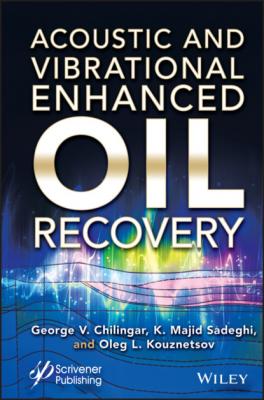Acoustic and Vibrational Enhanced Oil Recovery. George V. Chilingar
Чтение книги онлайн.
Читать онлайн книгу Acoustic and Vibrational Enhanced Oil Recovery - George V. Chilingar страница 16
 within the layer were derived. The presence of critical normal waves was established, similar to the appropriate concept of the wave theory in purely elastic wave guides near which the monotonous behavior of group velocities and fading coefficients disrupted. Thus, approximate analytical approach for the consideration of interaction between a layer (bed) with enclosing rocks and major parameters of flat monochromatic waves in the layer was used. Also, the escape of some vibration energy into the overlying and underlying rocks was considered.
within the layer were derived. The presence of critical normal waves was established, similar to the appropriate concept of the wave theory in purely elastic wave guides near which the monotonous behavior of group velocities and fading coefficients disrupted. Thus, approximate analytical approach for the consideration of interaction between a layer (bed) with enclosing rocks and major parameters of flat monochromatic waves in the layer was used. Also, the escape of some vibration energy into the overlying and underlying rocks was considered.
Bio determined the following boundaries of a low-frequency area where theoretic of results using both directions have been in a good agreement:
where η and ρf are, respectively, fluid viscosity and density; and k and m are rock permeability and porosity, respectively.
Sound dispersion in a micro-nonuniform medium is usually tied with the relaxation processes. These processes are leading to value leveling of some thermodynamic parameter ξ which depends on the wave pressure (or tension) in the enclosing medium and in inclusions. This leveling usually occurs through processes of heat conduction and diffusion through the surface of inclusions and is described by a relaxation time זr. For the frequencies ω >> 1 זr, the dispersion law may look like follows [29]:
where K is the frequency limit of the sound velocity; λ is the constant depending on the difference between the sound velocity limit values at high and low frequency and on זr; and K is the complex wave vector.
A similar dispersion law is typical also for nonuniform porous media filled with a viscous liquid due to the sound wave dispersion on the surface of nonuniformities and their conversion to rapidly fading viscous waves [28].
Let us assume that prior to the time moment t = 0, there were no wave disturbances in the medium. Then, a flat wave spreading from the side of positive x-axis values, according to the dispersion law Equation (2.1), is described by the following causal first-order wave equation:
The last term in the left part of Equation (2.2) may be shown as φ1/2(t)* дtu(t), where the asterisk indicates packing of two functions and
The core of the packing operator Equation (2.2) is a particular case of a more common Abel core:
where Г is the gamma function.
The core of Equation (2.3) kind may also be used for the description of more complex media. A singular function φα(t) at t = 0 is integratable if 0 ˂ α ˂ 1.
Next, the authors exam the complete second order equation for flat single-dimension waves extracted from Equation (2.2) and generalized according to Equation (2.3) for mathematical modeling of wave spreading within micro-nonuniform media. The causal single-dimensional second-order wave equation is
2D and 3D scalar wave equations of the medium model under review is easy to write down for an isotropic case by way of replacing the operator δxx with the dimension-appropriate Laplace operator. These equations obviously describe the wave spreading in some viscous-elastic medium. The right part of Equation (2.4) is different from zero at the availability of diffuse sources. The fundamental solution of Equation (2.4) must satisfy initial conditions
where δ(x) is Dirac delta function.
This fundamental solution enables the presentation of a general solution Equation (2.4) in the form of modified Duhamel integral, and in and of itself, it describes a wave impulse excited by an instantaneous point source. As Equation (2.4) is asymptotic at ω >> 1/τr, this model is applicable only near the wave impulse front during the time period or at a distance (C ∞ = 1) smaller than זr (which at accepted dimensionless units equals one).
The wave impulse front that emerged at the moment t = 0 and at the point x = 0 reaches the points +x and −x at the moment t = |x|. Solution of the problem Equations (2.4) and (2.5) represents the wave after this moment if to record t = |x| + τ and 0 ˂ τ ˂ τr=1:
where the function fα(ζ) may be represented through an inverse Laplace transform:
Its expansion in a series is
where H(ζ) is Heaviside step function. In a special case at α = ½, the series (2.8) converges to